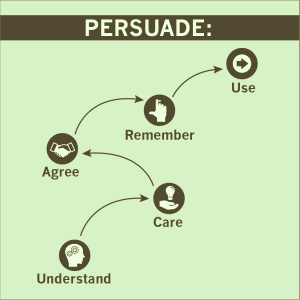By Dr. Ken Broda-Bahm:

Persuasion is at the core of what litigators do, not exclusively, but particularly in court. Despite that, aspiring lawyers train on a legal model that emphasizes some aspects of persuasion (like evidence and logic) while de-emphasizing or ignoring other aspects (like emotion, salience, and motivation). In a recent article, “Persuasion Principles for Lawyers,” lawyer and law professor Jerome Gautreaux writes about the problem, noting that law students are given a process in which “evidence is presented, arguments are made, judgments are made by the decision-maker based on the quality and quantity of the evidence and arguments,” but that ultimately, “this model deemphasizes factors other than the evidence and rational argument.” Over time, and thanks to the awareness brought by articles like Gautreaux’s, lawyers are gaining a broader perspective, and applying at least a handful of social science principles to practical persuasion in a courtroom. But, in my view, the field still needs to transition away from a focus on a grab-bag of persuasive advice and work towards a model of legal persuasion.
Several years ago in the pages of this blog, I shared my thoughts on what a model of legal persuasion might look like — one that was tailored to the unique conditions of courtroom persuasion. The gist of it is that it follows the decision-makers’ own process, moving from attention, to agreement, toward use. Those crafting a comprehensive message in trial should move through five questions aimed at the fact-finders’ perspective:
- Do they understand?
- Do they care?
- Do they agree?
- Do they remember?
- Do they use?
And underlying all of those questions is the notion of trust: Are they hearing a source, information, and arguments that are credible? I think the advantage of viewing persuasion, not as a disorganized bag of tricks but as a sequential process, is that it adds coherence to the ideas of effective advocacy and to the mindset it takes to execute them. Inspired by Gautreaux’s article, I want to use this post to expand on this model.
In context of each case, thoughtful advocates should ask what they are doing in order to meet the fact-finders at each stage. Drawing on some of my past posts, I believe some of the key considerations at each phase are as follows:
Bring Them to Understand (comprehension comes first)
- Speak conversationally, without jargon
- Use anecdotes
- Use experts who are teachers
- Use demonstrations so jurors participate
Invite Them to Care (motivation drives the process)
- Consider what is on the mind of your fact-finders
- Address existing knowledge, attitudes, beliefs, and ideology
- Think about the motivating principle behind your argument
- Account for both “low effort” and “high effort” routes
Get Them to Agree (ultimately they need to see the logic of your side )
- Understand their motivation to decide based on the evidence
- Start your argument with what they may already be thinking
- Reason with (and not at) your fact-finders
- Give them reasons to prefer your information over the other side’s
Set Them up to Remember (they need to retain it until they deliberate and decide later)
- Understand that they’ll remember highlights, not everything
- Attend to the ways jurors reconstruct their memories of the evidence
- Use visuals to make the point memorable
- Use techniques of emphasis to help the main message sink in
Encourage Them to Use (they need to not only convince themselves, but use the information in convincing others)
- Pay attention to the instructions
- Respect their (perceived) independence
- Build resistance against an ‘easy out’ that hurts you
- Talk about how they will proceed through the deliberation process
Although legal persuasion can be reduced to a list of do’s and don’ts, that is ultimately not the best way to understand it. As a goal and a mindset for an advocate, persuasion is about understanding, respecting, and adapting to the decision-maker.
____________________
Other Posts on the Process of Persuasion:
- See Persuasion as a Process (Toward a Unified Theory of Legal Persuasion)
- Persuade Through Process
- Appreciate the Nuance: Persuasion Isn’t Dead (Yet)
____________________